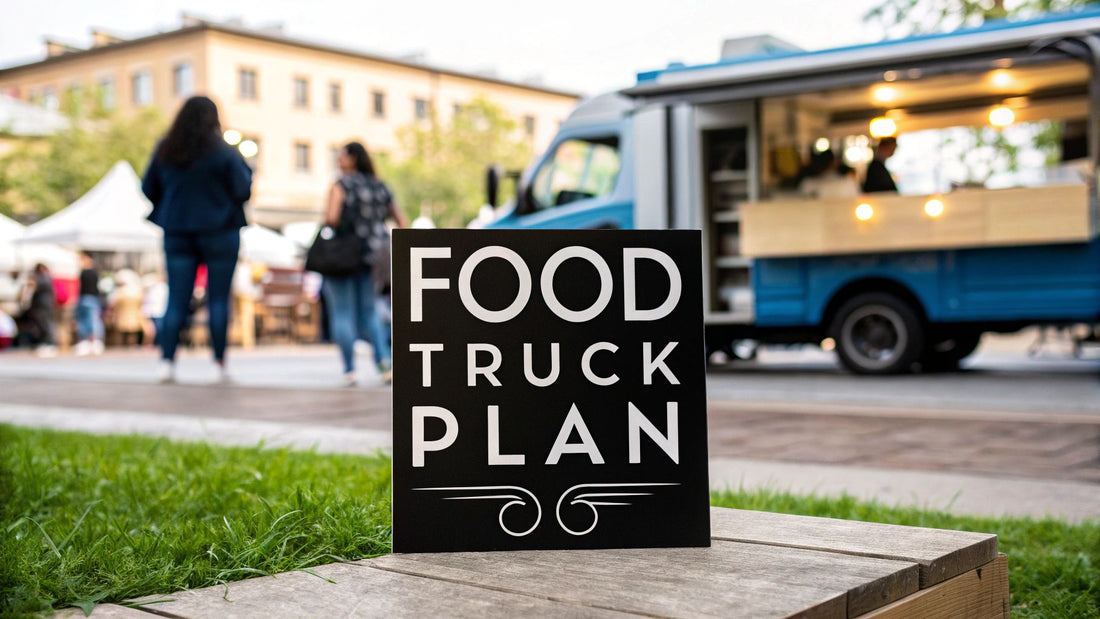
Your Food Truck Business Plan Made Simple
Share
Starting a food truck is about more than just amazing food—it's about building a real, sustainable business. Forget generic templates; this guide is your practical blueprint for a food truck business plan that actually wins over investors and steers your daily decisions. Honestly, it's the most critical piece of equipment you'll own.
The Blueprint For Your Food Truck Dream
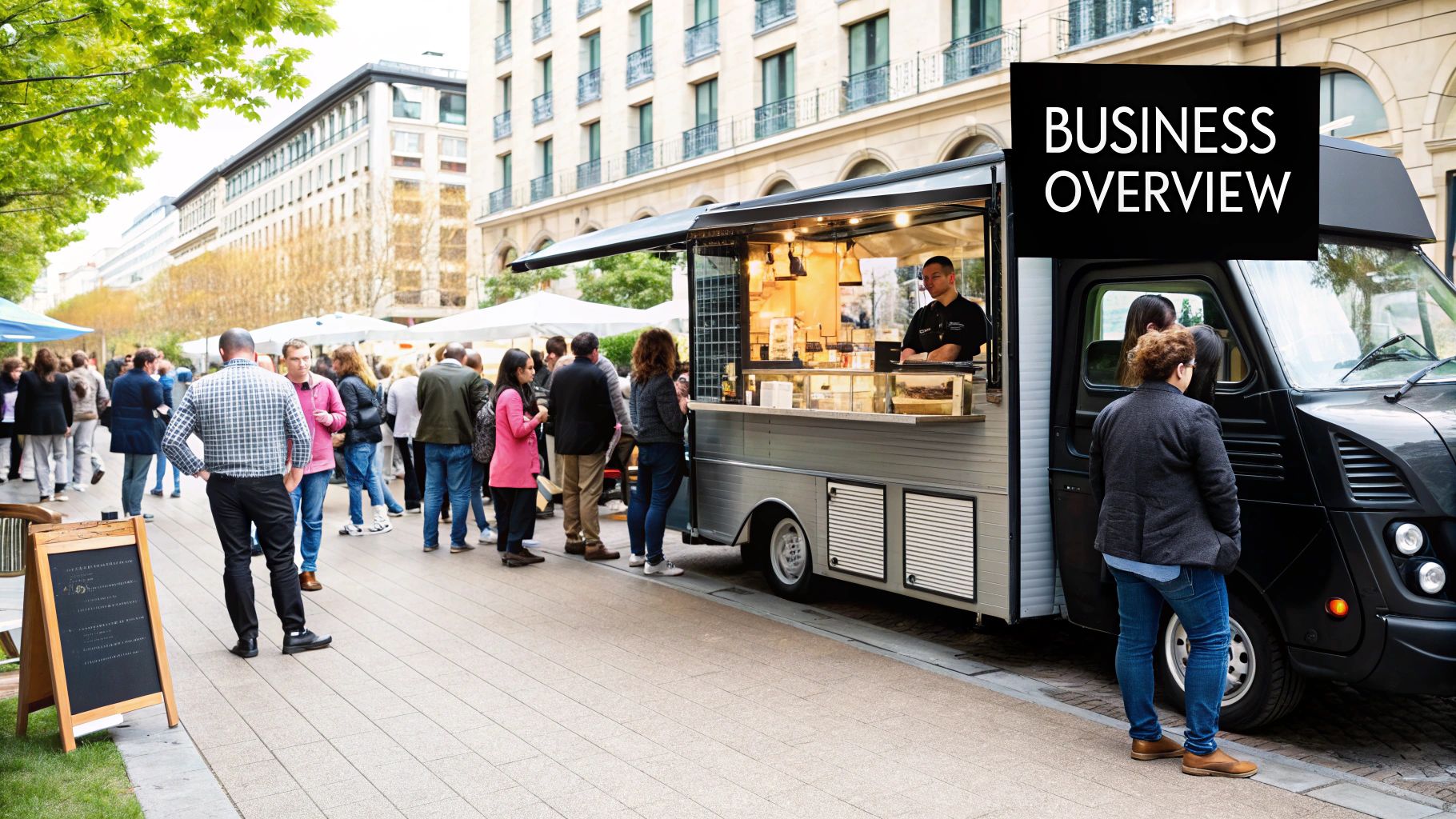
Jumping into the food truck world is a thrilling culinary adventure, but I've seen too many passionate chefs stumble because they overlooked the business side of things. Success isn't just about a great menu. A thoughtfully crafted food truck business plan is your roadmap, guiding every single decision from getting that first loan to managing the day-to-day grind. It's what turns your passion project into a viable enterprise.
This plan isn't some formal document you write once and then file away. Think of it as a living, breathing guide that helps you stay on track.
- Nail Down Your Vision: It forces you to get crystal clear on your concept, your mission, and what makes your truck the one people will cross town for.
- Secure Funding: Let's be real—lenders and investors won't even talk to you without a detailed plan. They need to see you've done your homework, analyzed the risks, and have a clear path to making money.
- Make Smarter Decisions: When you're trying to decide on equipment or how to price your tacos, your business plan provides the framework to make informed choices, not just guesses.
- Get Ahead of Problems: By thinking through potential challenges now—like permit delays or a supplier suddenly running out of your key ingredient—you can build contingency plans before a small hiccup becomes a full-blown crisis.
Why A Solid Plan Is Non-Negotiable
The mobile food scene is booming. The global food truck market is expected to grow from roughly US$ 4.9 billion in 2025 to US$ 7.5 billion by 2032, which is a compound annual growth rate of about 6.4%. You can learn more about these market trends and what they mean for newcomers. That growth is exciting, but it also means a lot more competition.
Without a solid plan, you're driving blind. It's so easy to underestimate your startup costs, completely misjudge who your customers are, or create a menu that, while delicious, simply isn't profitable to produce in a tiny kitchen on wheels.
A business plan is your most essential tool. It’s not just for bankers; it’s for you. It keeps you focused on your goals and provides a benchmark to measure your success against.
Think of it this way: you wouldn't build a house without a blueprint, right? The same goes for your business. This plan is the foundation that ensures your food truck dream is built to last. Now, let's walk through how to create each section, starting with your core concept.
Getting to Know Your Market and Competition
Before you even start daydreaming about your food truck's cool vinyl wrap or the perfect flat-top grill, you've got to put on your detective hat. A solid food truck business plan is built on knowing your local scene inside and out. This isn't about guessing; it's about real-world research to figure out where the customers—and the money—actually are.
Your first job is to get a crystal-clear picture of who you'll be feeding. This goes way beyond saying "office workers." You need to dig deeper and build a detailed profile of your ideal customer.
Who Are You Cooking For?
Think like a private investigator. Where do your future customers hang out? What’s their daily grind look like? Answering these questions is the secret to finding the most profitable spots and times to park your truck.
Let's break down some common customer types you'll encounter:
- The Busy Professional: They're on the clock with a short lunch break, so they need something fast, but they also appreciate quality. They’re often willing to pay a little more for a gourmet meal that doesn't eat up their afternoon. You’ll find them swarming business districts and office parks.
- The University Student: This crowd is usually watching their wallets, but they make up for it in sheer numbers. They love unique food that looks good on Instagram and is easy to share. College campuses and the surrounding neighborhoods are their natural habitat.
- The Festival Goer: When people are at a concert, street fair, or farmers' market, they're in a completely different mindset. They're there to have fun and are way more open to trying something new and indulgent. Price isn't as much of an issue.
- The Late-Night Crowd: Hanging around bars and entertainment venues after 10 PM? This group craves something satisfying and easy to eat on the go. Think big flavors and fast service.
Nailing this down is so important because it shapes everything else—your menu, your prices, and how you get the word out. A business plan that shows you've really thought about these different groups is infinitely more convincing to anyone looking to fund your dream.
Scouting Locations and Sizing Up the Other Guys
Once you know who you want to serve, it's time to find out where they are. This means getting your boots on the ground. Don't just stare at Google Maps; you need to physically go to your potential spots and see what's happening.
Spend some real time at these locations, and not just at noon on a Tuesday. A bustling business park at lunchtime can turn into a ghost town by 3 PM. That quiet park down the street? It might just come alive with soccer families and dog walkers in the evening.
While you're out there, you need to be doing some serious competitive analysis. And remember, your competition is more than just the other food trucks. It’s every single place someone can grab a quick bite.
| Competitor Type | What to Look For | How It Impacts You |
|---|---|---|
| Other Food Trucks | Their menu, prices, portion sizes, speed, and overall vibe. | This tells you if the market is saturated and where you can offer something they don't. |
| Quick-Service Restaurants | Lunch specials, how fast their line moves, and how busy they are. | They set the local expectation for price and convenience. Can you be faster or better? |
| Local Cafes & Delis | Their sandwich and salad game, coffee quality, and if they have seating. | This shows the demand for lighter, healthier, or simple grab-and-go food in that area. |
The point of all this snooping isn't to copy what everyone else is doing. It’s to find what they aren't doing.
Your goal is to find the gap in the market. That gap is where you'll plant your flag and create a unique business that people will flock to. This is how you discover your unique selling proposition (USP).
Cities are only getting denser, which is fantastic news for a mobile business like a food truck. More people packed into urban areas means more foot traffic and a bigger pool of hungry customers. Your mobility is a huge leg up on any restaurant stuck in one spot. As part of your research, look into how urbanization is fueling food truck growth and pinpoint those high-density areas in your own city.
By combining detailed customer profiles with real, on-the-ground intel about locations and competitors, your food truck business plan becomes a powerful tool. It shows you’re not just a passionate cook—you're a smart entrepreneur with a clear roadmap to success.
Crafting a Profitable Menu and Operation
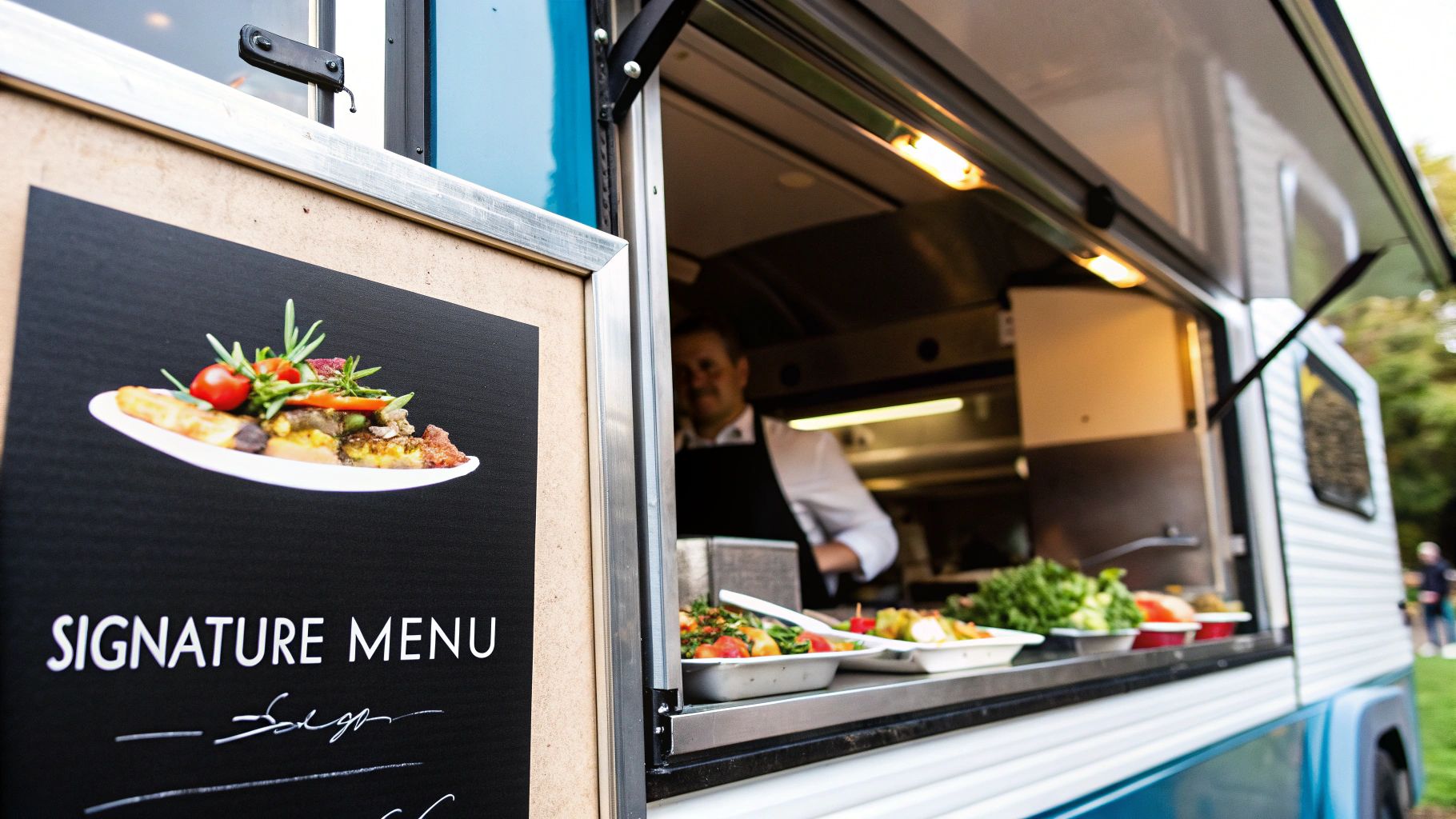
Let's be honest: your menu is everything. It's the heart and soul of your food truck. It's what people will remember, what they'll rave about, and what ultimately determines if you succeed or fail. But here's a hard truth I've learned from years in this business: a killer recipe that isn't profitable or efficient to make in a tiny kitchen will sink you. Fast.
The most successful food trucks I’ve seen all have one thing in common: they keep it simple. A focused, tight menu isn't a weakness—it’s your greatest strength. It means faster service, better quality control, and way less food waste, which is a killer for your bottom line.
Designing a Smart and Focused Menu
The reality of a food truck kitchen is that it's a constant battle against space. You have very little storage, a sliver of prep area, and a line of hungry people waiting during your busiest hours. Every single item on your menu needs to justify its existence.
A brilliant way to do this is through cross-utilization, where one core ingredient becomes the star of several dishes. It’s a total game-changer. For example, imagine your signature item is a perfectly slow-cooked brisket. That same brisket can be the foundation for:
- Brisket Tacos: Just add a different sauce, some slaw, and cotija cheese.
- Loaded Mac & Cheese: A scoop of brisket on top turns a side into a meal.
- Classic Brisket Sandwiches: An easy win that always sells.
This strategy radically simplifies your ordering and prep. You're buying fewer ingredients in bulk (which often gets you a better price) and drastically cutting down on potential spoilage.
A smaller menu isn't a limitation; it's a strategic advantage. It signals confidence in your offerings and ensures every plate you serve is consistently excellent.
Also, think about how people will eat your food. Can they manage it while walking around a festival or sitting on a curb? Handheld items are king for a reason. Tacos, gourmet sandwiches, and bowls are your best friends. Anything that requires a full knife-and-fork setup is usually a headache waiting to happen.
The Realities of Food Costing and Pricing
You cannot, under any circumstances, guess your prices. To build a business that lasts, you need to know the exact cost of every single plate you sell. This is called food costing, and it’s a non-negotiable part of your food truck business plan.
To figure out your cost per serving, you have to get granular. Break down every recipe to its smallest component—right down to the pinch of salt and dash of oil.
- List every single ingredient for one menu item.
- Calculate the cost of each ingredient for a single portion. If a 10-pound bag of potatoes costs $8 and you use a half-pound per serving, your potato cost is $0.40.
- Add it all up. That final number is your total plate cost.
Once you have that cost, you can set your menu price. A solid industry benchmark is to aim for a food cost percentage between 28% and 35%. So, if your plate costs you $3.50 in ingredients, you'll want to price it somewhere between $10 and $12.50 to cover your labor, fuel, insurance, and all the other overhead costs—and still make a profit.
Day-to-Day Operations and Choosing the Right Equipment
Your business plan needs to go beyond the food and map out your daily workflow. This covers everything from early morning prep runs to a commissary kitchen, the chaos of a lunch rush, and the final breakdown and cleaning at night. How smoothly this all runs comes down to the layout and equipment in your truck.
Choosing the truck itself is one of the biggest financial decisions you'll make. A brand-new, custom-outfitted truck can easily run over $100,000. A used one might seem like a bargain at $50,000 to $75,000, but be careful—it could come with hidden mechanical problems or an awkward kitchen layout that kills your efficiency.
Equipping that truck is just as important. In such a tight space, every piece of gear has to be reliable, compact, and absolutely essential. You’ll also have to navigate a maze of health codes dictating things like three-compartment sinks, specific refrigeration temps, and fire suppression systems. Making smart investments in restaurant equipment and supplies from the start will ensure you pass inspections and can serve customers effectively from day one.
Mapping Out Your Financial Future
Alright, let's talk numbers. This is where your food truck dream gets real. While your menu and brand are the heart of your business, the financial plan is the engine that actually makes it go. A clear, realistic, and detailed financial forecast is non-negotiable if you want to secure funding and, more importantly, stay in business for the long haul.
I know what you're thinking—spreadsheets and projections can feel overwhelming, especially for passionate chefs who'd rather be behind the grill. But you can't skip this part. Think of it as telling the financial story of your business: where the money comes from, where it goes, and how you plan to make it grow. Lenders and investors need to see you've thought through every single dollar.
Tallying Up Your Startup Costs
First things first, you need to create an exhaustive list of every single expense you'll face before you sell your first gourmet grilled cheese. This isn't the time for guesstimates; you need to do your homework and find real-world costs. Overlooking small things now can cause major cash flow headaches later.
Your startup costs generally fall into two buckets:
- One-Time Capital Expenses: These are the big-ticket items. The truck itself is the obvious one, but don't forget the cooking equipment, a solid point-of-sale (POS) system, and the cost of getting your truck wrapped with your awesome logo.
- Initial Operating Expenses: This is everything else you need to open your service window. It includes your first big food and paper goods order, all the necessary permits and licenses (which can easily run into the thousands), insurance premiums, and a marketing budget to create some buzz for your launch.
Here's a pro tip: Always build in a contingency fund. Set aside an extra 15-20% of your total estimated startup costs. This buffer is an absolute lifesaver when a generator dies mid-service or a permit fee is double what you expected. Trust me, something will go wrong.
To give you a clearer picture, here’s a sample breakdown of potential startup expenses. Use this as a starting point to build out your own detailed budget.
Sample Startup Cost Breakdown For A Food Truck
| Expense Category | Estimated Cost Range (USD) |
|---|---|
| Food Truck (Used) | $50,000 - $100,000 |
| Kitchen Equipment & Installation | $10,000 - $50,000 |
| Permits, Licenses & Certifications | $1,000 - $7,000 |
| Point-of-Sale (POS) System | $500 - $2,500 |
| Initial Food & Supply Inventory | $2,000 - $5,000 |
| Truck Wrap & Branding | $2,500 - $7,000 |
| Insurance (Initial Premiums) | $2,000 - $4,000 |
| Website & Marketing Materials | $500 - $3,000 |
| Legal & Professional Fees | $1,000 - $3,000 |
| Contingency Fund (15-20%) | $10,000 - $35,000+ |
Remember, these are just estimates. Your actual costs will depend heavily on your location, concept, and whether you buy a new or used truck. The key is to research every line item for your specific situation.
Building Projections That Get You Funded
Once you know your startup costs, you need to project your future financial performance. This is how you prove to potential investors that your food truck isn't just a cool idea—it's a viable business. They will pour over these documents to assess their risk.
You'll need to create three core financial statements:
- Profit and Loss (P&L) Statement: This shows your projected revenue minus all your expenses over time (do this monthly for the first year, then annually). It answers the question: "Will I be profitable?"
- Cash Flow Forecast: For a new business, this might be the most important document of all. It tracks the actual cash moving in and out of your bank account, ensuring you have enough money on hand to pay your staff and suppliers, even during a slow winter.
- Break-Even Analysis: This simple calculation tells you the exact sales volume you need to hit to cover all your costs. It answers the most fundamental question: "How many tacos do I need to sell each day just to keep the lights on?"
Knowing your numbers inside and out gives you incredible confidence when you walk into a bank or meet with an investor. It shows you're not just a great cook; you're a sharp business operator who understands what it takes to succeed. This infographic shows a simple marketing process that directly fuels the revenue side of your projections.
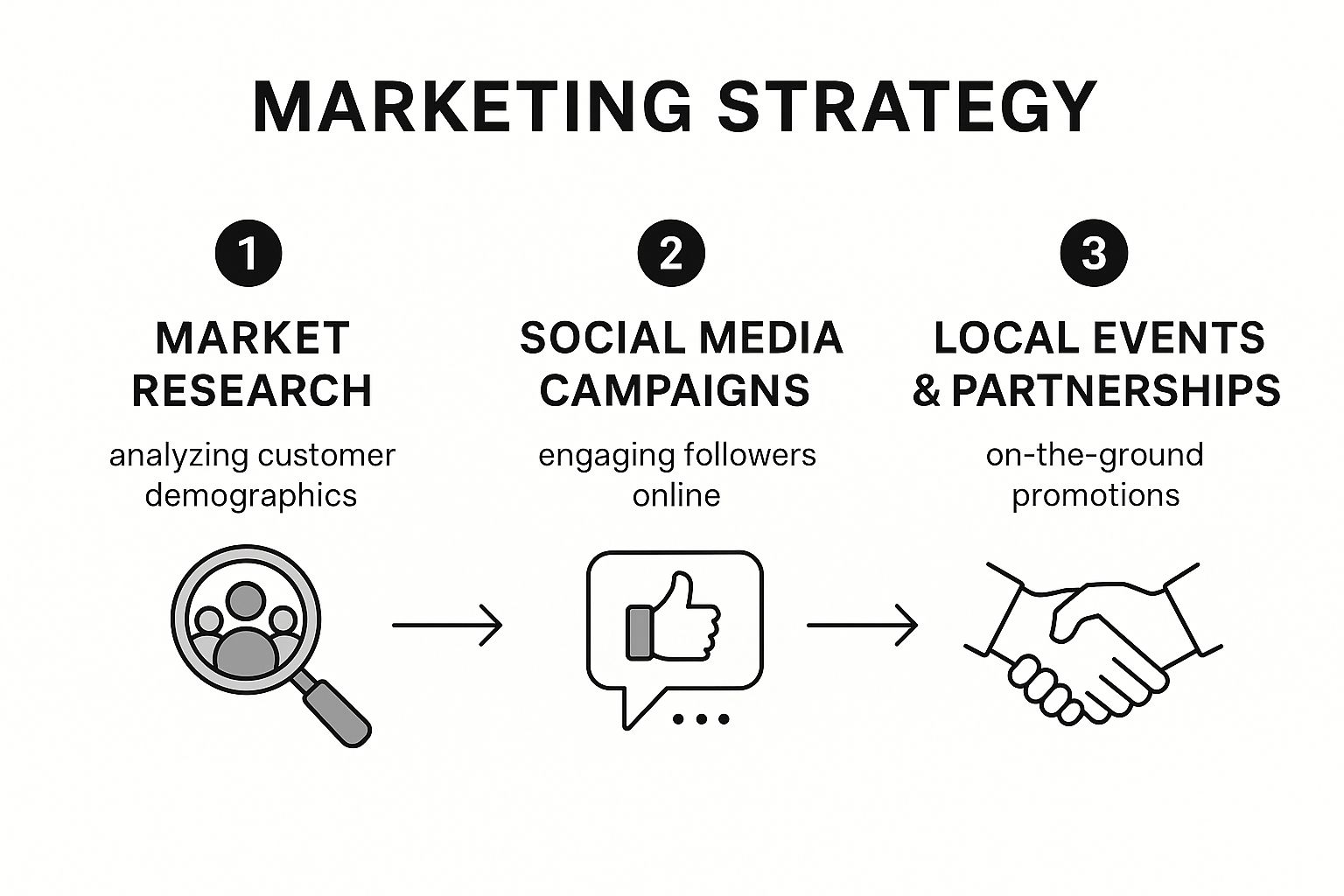
As you can see, a disciplined approach to marketing—from market research to social media and local events—is what drives the customer traffic that forms the basis of your sales forecasts.
Exploring Your Funding Options
With your solid financial plan in hand, you're ready to go find the money. There are a few well-trodden paths for funding a food truck:
- Small Business Administration (SBA) Loans: These government-backed loans from traditional banks often come with good terms. The catch? The application process is rigorous, and you'll need an impeccable business plan and strong personal credit.
- Equipment Financing: This is a loan specifically for buying the truck and kitchen gear. The equipment itself acts as collateral, which can sometimes make these loans easier to get than a general-purpose business loan.
- Crowdfunding: Platforms like Kickstarter or Indiegogo can be a fantastic option, especially if you have a unique concept with a great story. You essentially pre-sell your product by offering rewards (like free meals for a year or branded merch) in exchange for funding pledges.
- Personal Savings or Friends and Family: This is how many entrepreneurs get their start. If you go this route, I can't stress this enough: treat it like a formal business transaction. Draft a loan agreement and sign it to protect your relationships and avoid awkwardness down the road.
Ultimately, your financial plan is so much more than a document you show to lenders. It’s your operational roadmap. It helps you set menu prices, manage inventory, and make strategic decisions. Even the physical layout of your truck's kitchen has financial implications, as an efficient setup saves time and labor costs. For a deeper dive, check out these great tips on effective commercial kitchen design and layout.
Your Guide To Food Truck Marketing
https://www.youtube.com/embed/Oqw1Rj0MVJo
Having an incredible menu is a great start, but it won’t automatically draw a crowd. In the food truck world, your kitchen may be stationary, but your business is constantly moving. That means your marketing plan has to be just as mobile and dynamic as your truck.
Let's be honest: amazing food won't sell itself if people don’t know where to find you.
A strong marketing section is a non-negotiable part of your food truck business plan. It shows investors you have a real strategy for getting—and keeping—customers, which is just as critical as your financial forecasts. It proves you understand that being a great chef is only half the job.
Building An Unforgettable Brand Identity
Your brand is so much more than a logo. It's the entire vibe, the whole experience you deliver from the moment someone spots your truck. And it all starts with the truck itself.
Your wrap is your moving billboard. It needs to be bold and instantly recognizable from a block away. Think vibrant colors, a name that’s easy to read at a glance, and a design that screams what you're all about.
This identity must be consistent everywhere a customer interacts with you:
- Your Logo and Truck Wrap: This is your first impression. Is it fun and quirky for a gourmet ice cream truck, or rustic and bold for a BBQ rig?
- Your Packaging: Small touches like custom-printed napkins or sandwich wrappers make you look professional and help people remember you.
- Your "Voice": The way you write your social media captions and menu descriptions should reflect your brand’s personality. Are you witty? Straightforward? Enthusiastic?
Consistency is what builds recognition and trust. It’s what makes it easy for people to find you again and again.
Owning Your Digital Presence
For a food truck, social media isn't just a fun extra—it’s an operational lifeline. It's the single best way to shout, "Here's where we are today!" Platforms like Instagram, TikTok, and Facebook feel like they were made for mobile businesses.
But just posting your daily location is the bare minimum. To really connect with people, you need to share those drool-worthy food photos and videos. Get a close-up of that perfect cheese pull. Capture the steam rising from a fresh basket of fries. Show off the vibrant colors of your signature taco. In fact, a recent study found that 73% of diners have tried a new restaurant based on social media posts alone.
Pro Tip: Don't just post pictures of food. Post pictures of happy customers (with their permission!), behind-the-scenes prep, and stories about where you source your ingredients. Make your followers feel like they're part of your journey.
It's also a smart move to have a simple, mobile-friendly website. It doesn't need to be fancy. A single page with your menu, a little about your story, a gallery of your best photos, and clear contact info for catering gigs is all you need to create a professional online home base.
Smart Local Marketing And Partnerships
While a killer online presence is crucial, you can't ignore old-school, on-the-ground marketing. This is how you go from being just a truck to a beloved local institution.
Think about where your target customers already hang out and go meet them there. Partnering with local businesses is a classic win-win strategy.
- Breweries and Bars: Many don't serve their own food and are thrilled to have a quality option for their hungry, thirsty patrons.
- Office Parks: Talk to property managers about becoming the go-to lunch spot on Tuesdays or Thursdays.
- Local Events: Festivals, farmers' markets, and community fairs are absolute goldmines for reaching a huge, captive audience.
These partnerships give you a guaranteed spot and direct access to an established customer base. It’s one of the quickest ways to build momentum and get people talking. To make sure you're ready for these big days, having a solid plan is key. You can adapt this comprehensive checklist for a restaurant opening for a large-scale event launch.
Finally, don't forget to engage with online reviews on sites like Yelp and Google. A polite, timely response to a negative review can often turn a bad experience around, and thanking customers for positive ones shows you value their business. These small actions build a rock-solid reputation over time.
Common Questions From New Truck Owners
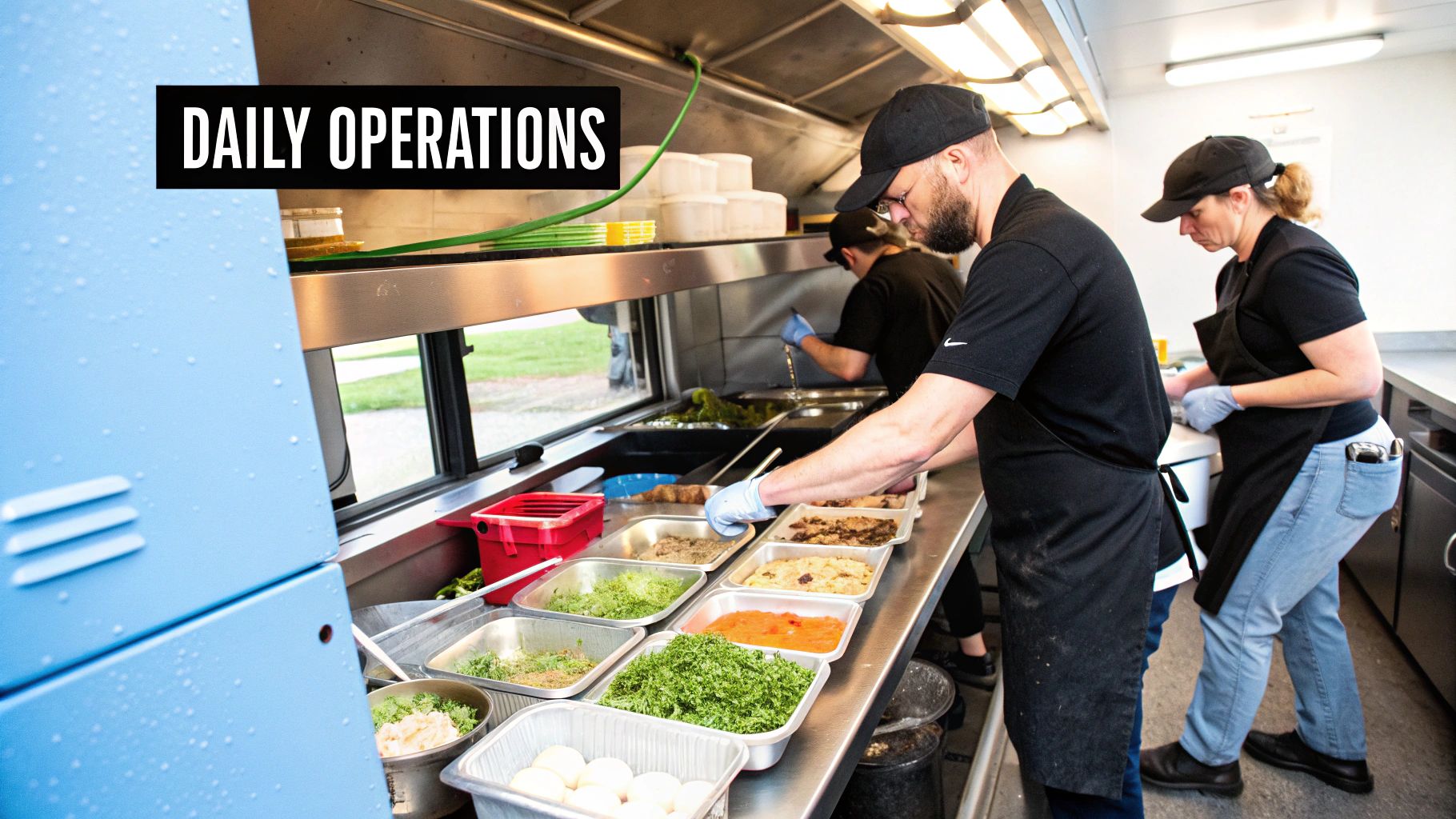
When you're mapping out your first food truck business plan, you're bound to hit a few roadblocks. It's completely normal. After guiding countless entrepreneurs through this process, I've seen the same critical questions pop up time and again.
Let's cut through the noise and tackle these head-on. Think of this as advice from someone who's seen what works—and what gets a business plan tossed in the "no" pile.
How Detailed Should My Financials Be For A Lender?
When you're asking a bank for money, there's no such thing as too much detail. Lenders aren't just looking for good ideas; they're looking for proof that you're a responsible business owner who has thought through every dollar. Your food truck business plan is your primary tool to build that trust.
At a minimum, your financial section needs to be rock-solid and include:
- A line-by-line breakdown of all your startup costs.
- A 12-month profit and loss projection, detailed month by month.
- Broader 3-year financial projections to show long-term viability.
But here's the part people miss: the story behind the numbers. You absolutely must include a break-even analysis. Show them precisely how many tacos or burgers you need to sell each day just to cover your costs. Connect this back to your market research, explaining your projected customer counts and average check size. This proves your numbers aren't just wishful thinking.
What Are The Most Important Permits I Need?
Navigating the world of permits can feel like a maze, and honestly, it's where a lot of new owners get bogged down. The rules can vary wildly from one city or county to the next, so local research is non-negotiable.
That said, some permits are practically universal. You can bet on needing:
- A standard business license
- An Employer Identification Number (EIN)
- Food handler's permits for yourself and any staff
- A health department permit for the truck itself
From there, it gets more specific. Expect to need mobile vending licenses, fire safety inspections, and sometimes, separate permits for every single town you want to park in. The U.S. Chamber of Commerce has pointed out that a food truck can easily spend over $28,000 in a single year on permits and compliance alone.
Key Takeaway: Start the permit application process the moment you decide to move forward. It can take months, and a single missing piece of paper can keep your truck parked and your business closed.
Should I Buy A New Or A Used Food Truck?
This is one of the biggest forks in the road you'll face. It's a classic budget-versus-reliability dilemma, and your business plan needs to show you've carefully considered both sides.
- New Truck: Going brand new means a custom-built kitchen tailored to your workflow. Everything is under warranty and up to code. The downside? A hefty price tag, often north of $100,000.
- Used Truck: You can get on the road for much less, with used trucks often in the $50,000 to $75,000 range. The trade-off is the risk. You could be inheriting someone else's mechanical nightmares or a clunky kitchen layout that kills your speed during a lunch rush.
Many successful owners find a happy medium: they buy a solid used truck with a good engine and then outfit it with brand-new, high-quality kitchen equipment. This strategy balances the initial investment while ensuring your most critical tools are reliable and efficient.
No matter which truck you choose, the right equipment is what will make or break your daily service. At Encore Seattle Restaurant Equipment, we help restaurant owners and chefs discover the latest news and exclusive deals on restaurant equipment and supplies. Explore our extensive inventory and get expert advice today.
